 advertisements advertisements
|

|
CA Science Center reopens space shuttle Endeavour's payload bay
February 22, 2023 — Space shuttle Endeavour is about to get its 'boom' back.
No, the California Science Center is not planning to reignite the retired spacecraft, which since 2012 has been on display at the Los Angeles institution. Despite the work now underway to exhibit Endeavour in a vertical, launchpad-like display, the center's plans call for the space shuttle to remain quiet.
Rather, the orbiter's payload bay has been reopened for the first time in nine years to complete outfitting the vehicle's cargo hold.
"We are installing a replica Orbiter Boom Sensor System [OBSS]," said Dennis Jenkins, director of the California Science Center's project to display Endeavour. "At the time of the original [payload] installation, we were not certain this item would be visible to guests in the final configuration. A detailed evaluation at the end of the 2014 installation showed it would be, so we decided to add the OBSS to provide an authentic representation of the STS-118 payload configuration."
In a much more publicized move almost a decade ago, the science center pulled open Endeavour's two 60-foot-long (18-meter) doors in an event that was called "Go for Payload." Over the course of three weeks in October 2014, engineers and curators used large cranes to load the shuttle's empty bay with a flown Spacehab logistics module and replica components modeled after how Endeavour looked on its 20th mission, STS-118, in 2007.
STS-118 was chosen because that flight included educator-astronaut Barbara Morgan on its crew and the California Science Center is focused on education.
Later this year, Endeavour will be transported from its pavilion to the construction site of its new home, the Samuel Oschin Air and Space Center. There, the orbiter will be mated with NASA's last remaining, built-for-flight external fuel tank and two solid rocket boosters assembled from previously launched parts.
Once completed, the exhibit will feature the world's only indoor display of a full space shuttle stack. Endeavour will appear as it did on the launchpad with one exception: one of its payload bay doors will be open, allowing guests to see the equipment inside.
Hence the need for the OBSS.
Introduced as a safety measure after the loss of space shuttle Columbia in 2003, the OBSS was a 50-foot-long (15.24-m), camera-and-laser-tipped extension to the Canadarm robotic arm. Astronauts used the boom to inspect the orbiter's wings and underbelly to ensure they were not damaged during launch or while in space.
When not in use, the OBSS was stored on the starboard, or right-side sill of the payload bay. In Endeavour's exhibit, the boom will covered by the still closed starboard-side door, but depending on where visitors are standing, they might still be able to see where it should be mounted inside.
With the shuttle fleet retired since 2011, the ideal addition for Endeavour's display would be the real OBSS. It, however, is out of reach.
"The OBSS usually used by Endeavour was left at the ISS," Jenkins said.
On Endeavour's last mission, the boom was removed and stowed outside of the International Space Station. Though its sensors are long dead, the OBSS could be used to augment the station's Canadarm2 robotic arm in order to reach areas the arm alone cannot.
The installation of the replica OBSS is expected to take a few days, with the payload bay set to be closed by the end of the week. After that, Endeavour will almost be ready to go vertical.
"For the most part, Endeavour is ready," said Jenkins. "We are planning on changing out some of the LED lighting since that technology has improved considerably in he past nine years. Just before we stack we will need to change out the attach bolts — the bolts holding the ship to the overland transporters are smaller than the flight bolts that attach to the external tank — and do a final foreign object debris check."
As for Endeavour's new home, it too is on track for the orbiter to arrive.
"Construction is proceeding on schedule," Jeffrey Rudolph, president and chief executive officer of the California Science Center, told collectSPACE. "It is exciting to witness the new Samuel Oschin Air and Space Center take shape." |
|
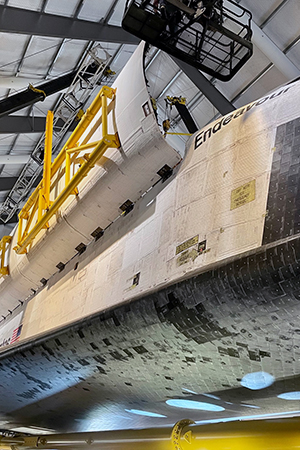
Crane operators work with former NASA contractors and a museum curator to carefully open space shuttle Endeavour's payload bay doors inside the Oschin Display Pavilion at the California Science Center in Los Angeles on Tuesday, Feb. 21, 2023. (Lois Huneycutt)
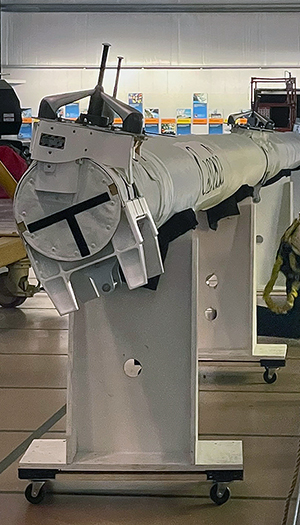
A replica of Endeavour's Orbiter Boom Inspection System (OBSS), furnished for the California Science Center by Guard-Lee, Inc., will be installed in the space shuttle's payload bay. (Lois Huneycutt) |

Both of space shuttle Endeavour's 60-foot-long (18-meter) payload bay doors are being opened for the installation of the replica Orbiter Boom Sensor System (OBSS). When exhibited vertically in the new Samuel Oschin Air and Space Center, only the port side door will remain open, providing visitors a view of the equipment inside. (Lois Huneycutt) |
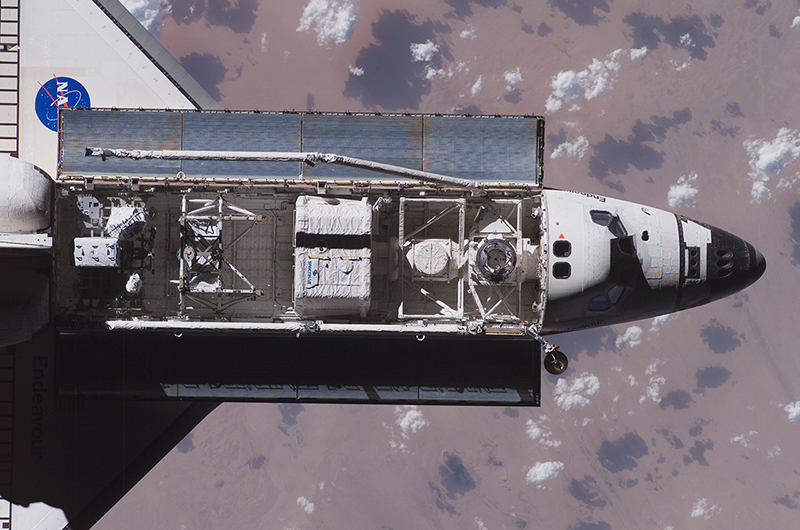
The California Science Center is basing its space shuttle Endeavour display on how the orbiter was configured for its 20th mission, STS-118, in 2007. As seen here in Earth orbit, the Orbiter Boom Sensor System (OBSS) can be seen stowed on the lower starboard sill with the Canadarm robotic arm partially deployed on the opposite side. (NASA) |
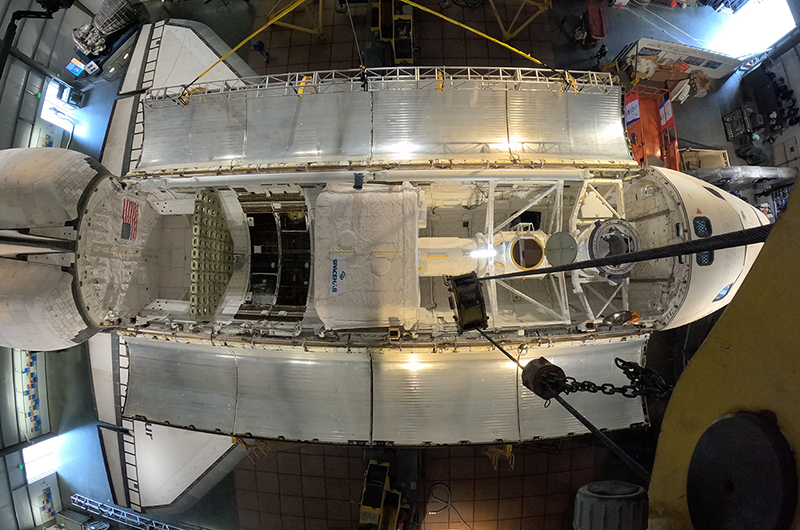
An overhead view of the space shuttle Endeavour after its payload bay doors were opened on Wednesday, Feb. 22, 2023. (California Science Center) |
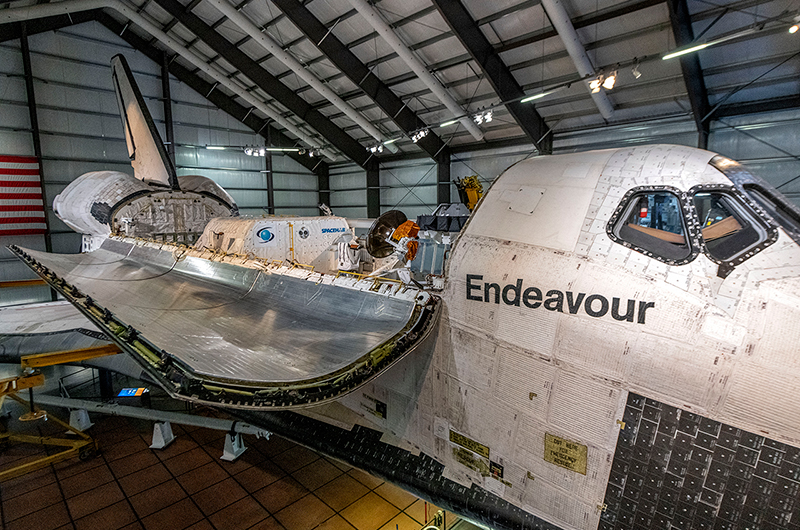
A view of Endeavour's open payload bay with the Orbiter Boom Sensor System (OBSS) waiting installation below. (California Science Center) |
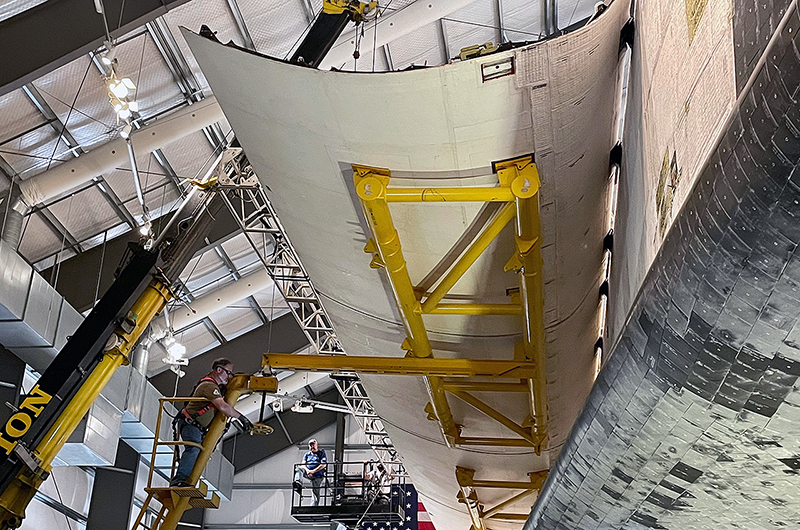
The California Science Center used the orbiter's original yellow strongbacks to support Endeavour's payload bay doors as they were opened for only the second time inside the Samuel Oschin Display Pavilion since the space shuttle went on exhibit in 2012. (Lois Huneycutt) |
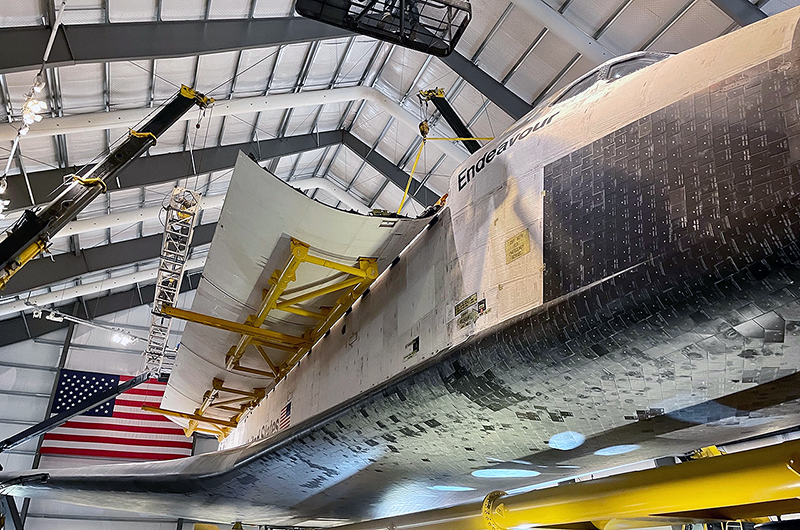
The work to install the replica Orbiter Boom Sensor System (OBSS) in space shuttle Endeavour's payload bay is expected to take less than a week and the cargo hold will be closed in preparation for the orbiter's move to the construction site of the Oschin Air and Space Center. (Lois Huneycutt) |
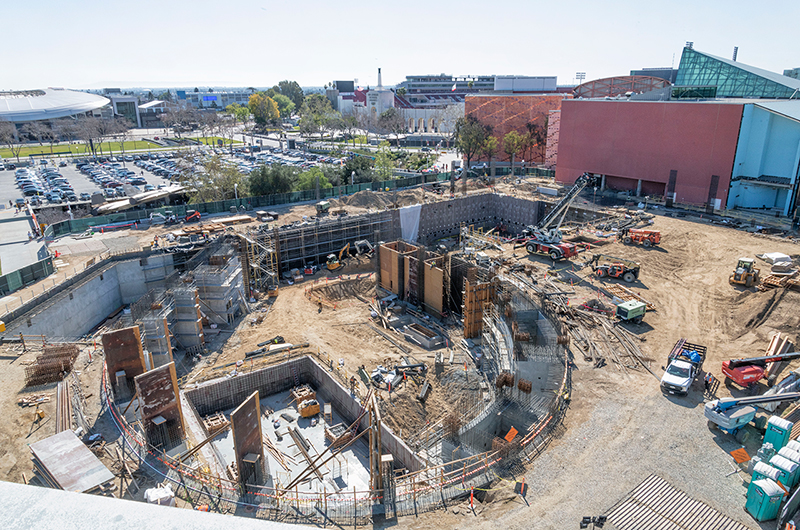
A view of the construction site for Endeavour's new home, the Samuel Oschin Air and Space Center, as located adjacent to the California Science Center. Endeavour will be raised vertically at this site and then the building will be completed around it. (California Science Center) |
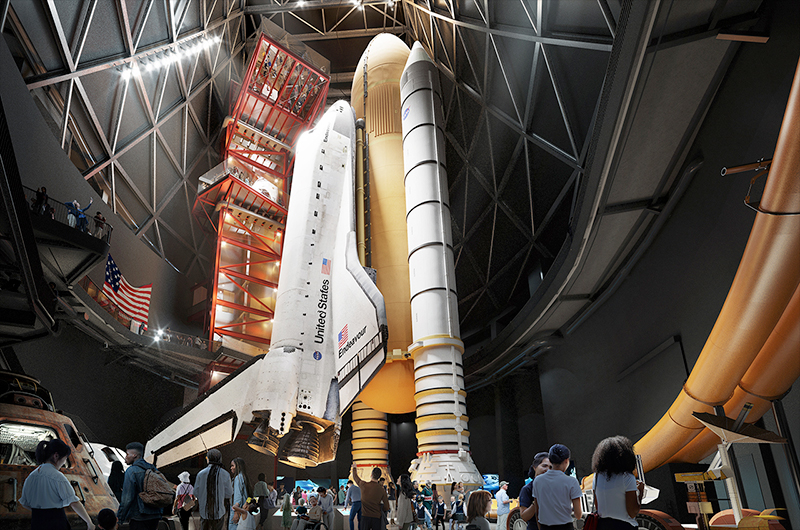
Artist's rendering of the space shuttle Endeavour inside the Samuel Oschin Air and Space Center. From the gantry tower, visitors will be able to see inside the orbiter's cargo hold through its open port-side payload bay door. (California Science Center/ZGF) |

Space shuttle Endeavour with its payload bay open for only the second time since going on display at the California Science Center in 2012. (CSC)
Update: A look at the OBSS after its installation on Wednesday, Feb. 22, 2023: |
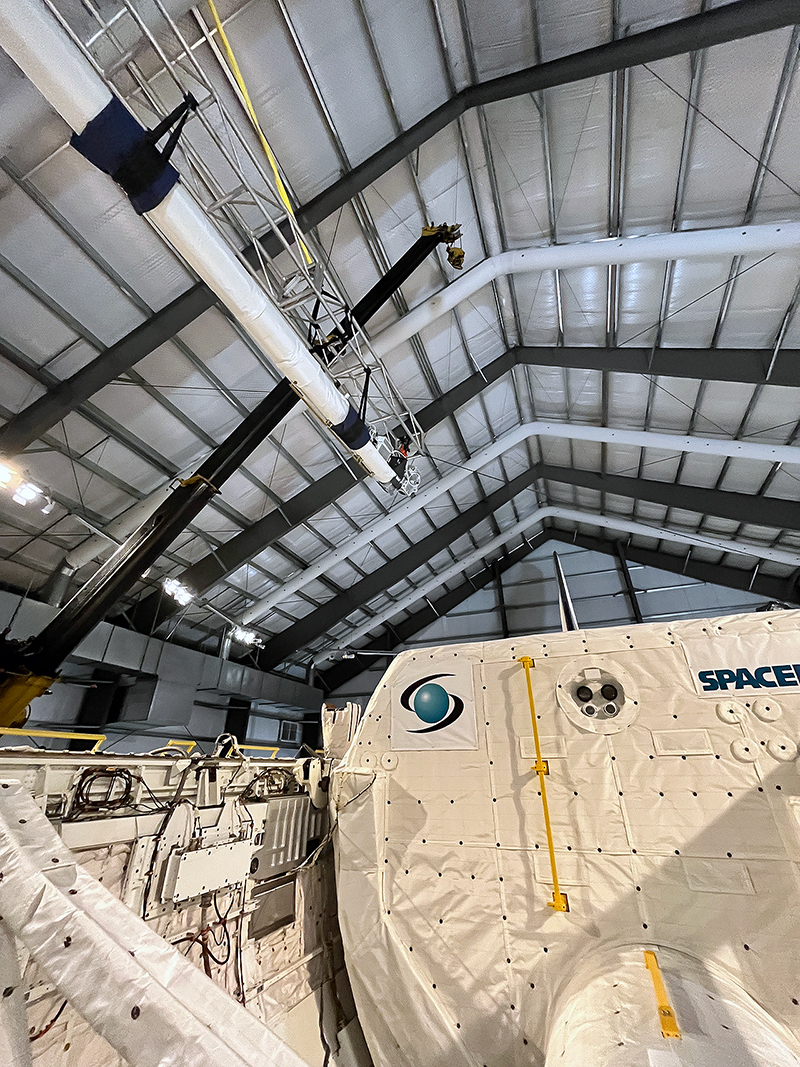
The replica, 50-foot-long (15.24-m) Orbiter Boom Sensor System is hoisted high above Endeavour's payload bay before being installed. (CSC) |
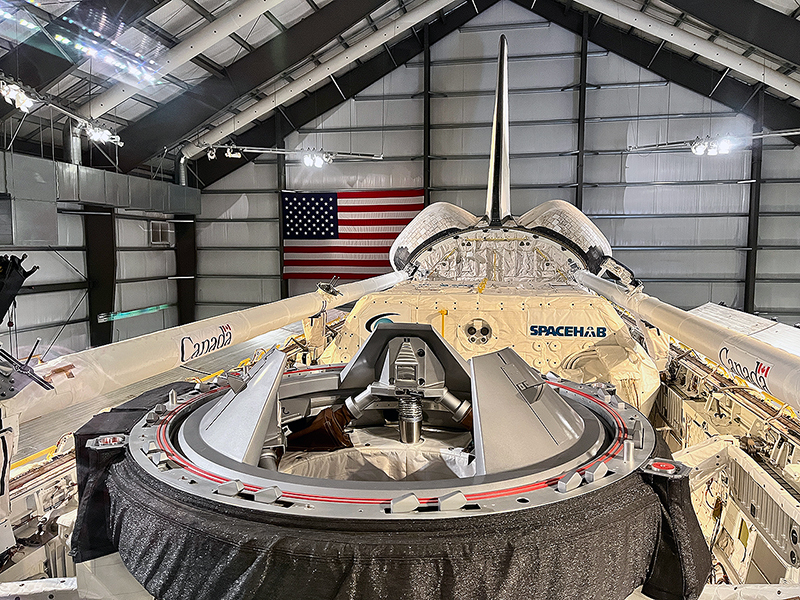
The replica Orbiter Boom Sensor System is seen after its installation on the starboard sill of Endeavour's payload bay. (California Science Center) |
|

© collectSPACE. All rights reserved.
|
|

|

|
